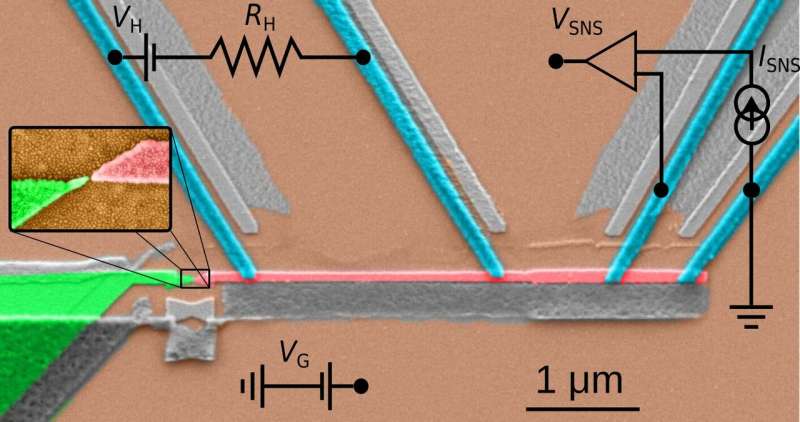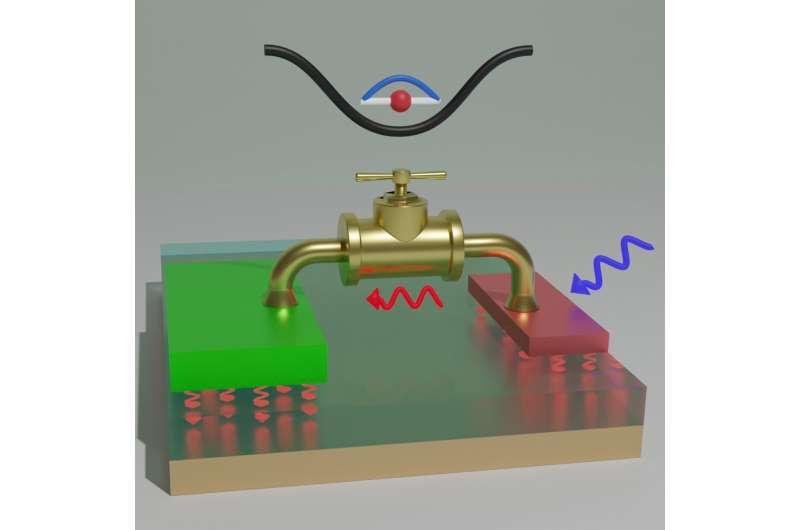January 12, 2021 feature
The realization of a single-quantum-dot heat valve

While many research teams worldwide are trying to develop highly performing quantum computers, some are working on tools to control the flow of heat inside of them. Just like conventional computers, in fact, quantum computers can heat up significantly as they are operating, which can ultimately damage both the devices and their surroundings.
A team of researchers at University Grenoble Alpes in France and Centre of Excellence—Quantum Technology in Finland has recently developed a single-quantum-dot heat valve, a device that can help to control the flow of heat in single-quantum-dot junctions. This heat valve, presented in a paper published in Physical Review Letters, could help to prevent quantum computers from overheating.
"With the miniaturization of electronic components handling of excess heat at nanoscales has become an increasingly important issue to be addressed," Nicola Lo Gullo, one of the researchers who carried out the study, told Phys.org. "This is especially true when one wants to preserve the quantum nature of a device; the increase in temperature does typically result in the degradation of the quantum properties. The recent realization of a photonic heat-valve by another research group ultimately inspired us to create a heat valve based on a solid-state quantum dot."
One of the key objectives of the recent study carried out by Lo Gullo and his colleagues was to demonstrate the feasibility of controlling the amount of heat that flows across a quantum dot junction, while also enabling the flow of a set amount of electric current. To design their single-quantum-dot heat valve, the researchers placed a gold nanoparticle between two metallic contacts, using it as a junction. This nanoparticle is so small that it can be used to intervene on a single energy level, acting as a bigger artificial atom would with several accessible energy levels.
"By properly tuning the external parameters it is possible to allow the electrons in one of the contacts to flow through only one of the levels of this artificial atom and reach the other contact," Lo Gullo explained. "The single-level quantum dot therefore acts as a bridge between the two metallic contacts."
In normal circumstances, the exchange of energy is only possible when the energy level of a quantum dot is in resonance with the energy of the electrons in the contacts. In the device developed by Lo Gullo and his colleagues, however, the presence of the contacts changes the properties of the artificial atom, by broadening its energy levels.
"This effect is at the heart of the heat-valve effect we have studied," Lo Gullo added. "The broadening amounts to the creation of virtual states, which are not classically accessible and allow electrons to flow from one contact to another, by carrying energy and giving rise to the heat-valve effect we reported."
In larger (macroscopic) conductors, researchers have identified a simple and universal relationship between their ability to conduct electrical charge and their ability to conduct heat. This relationship is outlined by a theoretical construct known as the Wiedemann-Franz law.

In quantum devices such as the one developed by Lo Gullo and his colleagues, however, things are not as straightforward. This is due to the quantization of charge and energy, which leads to deviations from the Wiedemann-Franz law.
"Using the most basic quantum mechanical picture (called semi-classical), one would expect a quantum dot junction not to conduct heat at all," Clemens Winkelmann, another researcher involved in the study, told Phys.org. "Our measurements, however, show that this is not true, and the theoretical explanation is related to quantum fluctuations, exactly as in the Heisenberg uncertainty principle, which partly restore the energy and thus the heat flow."
When they were developing their device, the researchers had to overcome a number of technical challenges. For instance, they had to identify a strategy to measure the temperature (and temperature differences) locally inside a quantum device. Ultimately, one of the greatest achievements of their study is that they were able to collect these measurements and thus gain a better understanding of how heat is managed inside quantum devices.
"Electronic devices produce dissipation when they treat information, and this leads to the well-known overheating issues observed in classical processors, which also occur the quantum world," Winkelmann said. "Overheating can perturb the logical operation of the device, leading to errors. Our work provides a better understanding of how heat is generated and can be drained in such a device."
By introducing a strategy to achieve control over the heat flowing through the smallest junctions in quantum devices, the recent paper by Lo Gullo, Winkelmann and their colleagues could open up interesting new possibilities related to an emerging field of study known as solid-state thermotronics. Solid-state thermotronics research investigates the possibility of controlling heat flows through temperature gradients in a similar way to that in which electrical currents and voltages are controlled in existing devices.
"Solid-state thermotronics is a relatively new field, but important progress has been made, such as the realization of heat valves, thermal diodes and transistors, energy harvesters and even the proposals of thermal logic gates," Lo Gullo said. "We provided yet another example of the feasibility of controlling and measuring heat currents and temperatures in solid-state devices."
In the future, the heat valve developed by this team of researchers could improve the reliability and safety of quantum devices, reducing the risk of overheating. In their next studies, Lo Gullo and Winkelmann would like to devise strategies to measure dissipation over time. In other words, instead of focusing on a quantum device's steady-state heating, they plan to examine single, elementary quantum-dissipative processes, such as the tunneling of a single electron or a single 2π slip of the quantum mechanical phase.
"There are many possible directions for future research," Lo Gullo added. "We are currently looking at junctions with a more complex structure to see if they offer some advantages in terms of range of operability. Another appealing possibility is to achieve time-resolved control over the heat flow, thus allowing real time operations in view of applications to thermotronics."
More information: Single-quantum-dot heat valve. Physical Review Letters(2020). DOI: 10.1103/PhysRevLett.125.237701.
Journal information: Physical Review Letters
© 2021 Science X Network




















